Tuesday 22 February 2011
Galapagos fur seal - Nature's Most Insulated Fur Bearer
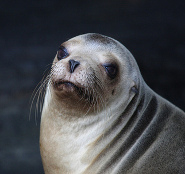
The
Galapagos fur seal (
Arctocephalus galapagoensis) is one of the smallest eared seals and is only 1 1/2 meters in length (4.5 feet) and they generally weigh just under 64 Kilograms (141 lbs). These seals have a brownish coat and are found in the Galapagos Island Chain, just west of Ecuador. Though they were once completely endemic to this island chain, colonies of Galapagos fur seals have been established around the world by the Organization for Research and Conservation. As a result, they can now be found as far north as
Peru.
Galapagos fur seals have a diet that consists of mainly fish and cephalopods, with their dietary preferences centering mainly around the Galapagos reef octopus and Broadclub Cuttlefish. The hunting duties of the colony are delegated to the female of the species and each female assumes a territory that is a satellite of the larger fur seal colony. The female will use this territory to hunt for food and breed her pups. Seal pups will nurse for approximately two years before they head off on their own and establish their own territories.
The food supply for Galapagos fur seals are plentiful for most years. This changes during an El Nino season, however. This is because an El Nino causes the waters around the islands to warm dramatically, thus driving their primary prey to cooler waters. This can have a devastating effect on the colonies of the fur seals because the adult seals tend to feed themselves before they feed their young, thereby causing many of the pups to die from starvation.
What makes the Galapagos fur seal so unique and distinguishable from other seal species is its lush coat. The fur coats of this species are fuller and thicker than other species, giving them the ability to dive to extraordinary depths, even in very cold waters. It also enables them to withstand temperatures below freezing, making them one of the most insulated animals in the Galapagos Island Chain. Unfortunately, their characteristic fur coat is also almost what drove them to extinction. During the late nineteenth century, these seals were extensively hunted for their fur coats, which were highly prized in the United States and Europe. In recent years this trend has been reversed and the Galapagos fur seal population is once again vibrant and healthy.
Picture of the Galapagos fur seal by Andy Jones (
original), licensed under
Attribution-NonCommercial-ShareAlike 2.0 Generic (CC BY-NC-SA 2.0)
You can help spreading the word about this animal by liking it on facebook
Permanent Link
Monday 21 February 2011
Olingo - Expert Jumper
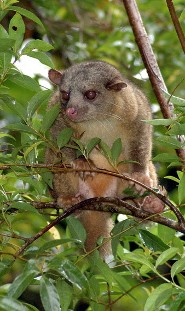
The
Olingo (
Bassaricyon gabbii) is a light brown and cream colored creature that has a length of between 35 and 48 centimeters or 14 and 19 inches and a weight of 10 to 15 kilograms or 22 to 33 pounds. They have tails that are quite long, usually about the length of the body. The Olingo also has a round head and small round ears. The eyes possess large pupils and are typically cinnamon in color. The creature has 40 razor sharp teeth in the form of canines, premolars, and molars.
Olingos typically eat during the night with this diet consisting primarily of fruits, lizards, and insects. The typical predators of the species consist of snakes as well as large cats such as the
jaguar.
The Olingo has no definitive breeding season. The mating is started by the males of the species who produce penetrating and drawn out calls after they detect that a female in heat is nearby. Mating will then take place and will occur numerous times between the two animals.
The animal has an average gestation of 73 days with one birth resulting from the pregnancy. The newborn is deaf as well as blind and has short and sparse hair that is grey-black in color. The newborn is typically about 22 centimeters or 9 inches in length and 55 grams or 2 ounces in weight. The eyes and the ears will typically begin functioning within the first two weeks of life. It becomes fully mature when it reaches the age of 2 years.
It has been difficult for researchers to determine the exact behavior of the Olingo as it typically lives within thick forest environments and are primarily nocturnal, solitary, and arboreal. The creatures typically sleep within the cavities of trees and are excellent jumpers and climbers. In fact, they are able to jump as far as 3 meters from one limb to another. Because of this incredible ability to jump, they are able to often avoid their predators such as snakes and wildcats.
Olingos live in the rainforest located in Northeastern South America and Central America. They primarily live between sea level and 2,000 meters and remain in the tops of trees in the dense forest and they rarely travel from the treetop to the forest floor.
Olingos are quite rare, however, they are rated as IUCN which is the lower risk so they are fortunately not close to being extinct.
Picture of the olingo by Jeremy Gatten, licensed under the
Creative Commons Attribution-Share Alike 2.0 Generic license.
You can help spreading the word about this animal by liking it on facebook
Permanent Link
Monday 14 February 2011
Naked Mole Rat - More Than Meets The Eye
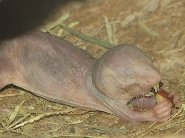
The
naked mole rat (
Heterocephalus glaber) is a
rodent, known for its burrowing and is indigenous to East Africa. The mole rat possesses a number of characteristics which allow it to survive in underground and harsh environments.
The average naked mole rat is between 3 to 4 inches (8 to 10 centimeters) in length and weighs between 1.1 and 1.2 ounces (30 to 35 grams). They have small eyes, poor sight, and have legs that are quite short and thin. They are also able to move backward and forward at the same quick pace and have large teeth that allow them to dip. The term "naked" comes from the fact that they have very little hair and gray-pink skin.
The species is highly adapted to situations in which oxygen is limited within tunnels of their habitat. The lungs are small and their blood is greatly able to bond oxygen. They have very low metabolic and respiration rates. During periods of drought and hunger, the metabolic can decrease further to about 25% of its normal level.
The naked mole rat lives predominantly in the dry tropical grasslands in East Africa with large concentrations being concentrated in Somalia, Kenya, and southern Ethiopia. Groups of around 80 individual mole rats (although it can be as few as 20 and as many as 200) live within a complex burrowing system within the African desert. These tunnel systems can be quite long, between two to three miles in length.
There is a complex hierarchical structure where one queen and between 1 and 3 males reproduce, the other naked mole rats are workers and sterile. Dimorphism exists between the males, two forms of workers (tunnel digging/gathering and soldiers), and the breeding males. The breeding males and the queen can keep up their relationship for several years. The queens can live for a period of between 13 and 18 years and are quite hostile towards other females. Upon the death of the queen, another female will become queen in her place.
The naked mole rat mostly eats large tubers that they find underground during their mining exhibitions. However, they are also known for eating their own fecal matter. One tuber, depending upon its size, can feed a colony for several months or years as they only eat the inside of the tuber. They leave the outer parts so that the tuber is able to regenerate.
Naked mole rats are currently not a threatened species. Although their living conditions are tough, they are a widespread species.
Naked mole rats help in cancer research, because they never get cancer (
read here).
You can help spreading the word about this animal by liking it on facebook
Permanent Link
Tuesday 08 February 2011
Underwater Diner - The Spotted Turtle
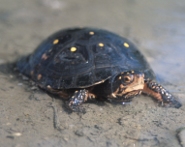
The
Spotted Turtle (
Clemmys guttata) is a small freshwater turtle measuring about 9 to 12.7 cm (3.5 to 5.0 inches) in length and weighing about 8 to 12 ounces (226 to 340 grams). Found mainly along the east coast of the United States, from southern Maine to northern Florida, as well as the Midwest and southern parts of Canada near the Great Lakes, the Spotted Turtle prefers to live in ponds, ditches, swamps and marshes. The Spotted Turtle's shell varies in color from black to bluish black, accented with yellow spots that extend to the legs, neck and head. The Spotted Turtle does not reach maturity until 8 to 10 years of age and the life expectancy of a typical Spotted Turtle is about 25 years.
What makes the Spotted Turtle so fascinating is its eating habits. The Spotted Turtle is an omnivore and will eat a wide variety of foods, from algae and other aquatic vegetation to salamanders, fish, slugs, worms and other small insects. However, the Spotted Turtle will consume its food exclusively in the water. Even if it finds food on land, the Spotted Turtle will return to the water to consume it.
The breeding period for the Spotted Turtle begins in March and ends in May. The female turtles will begin searching for nesting areas at the end of March. Once a proper nesting spot is found, the females will lay only about three to four eggs each. The eggs hatch in about 10 to 12 weeks and the 1-inch (2 cm) hatchlings begin their search for wet, marshy areas to secure food and shelter. Predators of the Spotted Turtle include raccoons,
muskrats,
skunks, otters, bears and eagles. The eggs of the Spotted Turtle are also at risk of being consumed or destroyed by foxes, skunks, raccoons and ants.
However, due to pollution and destruction of natural habitats, the population of wild Spotted Turtles is in decline. The collection of Spotted Turtles for pets has also added to the decrease in population. The Spotted Turtle is listed as an endangered species in Illinois and Ohio, a threatened species in Vermont and Maine, a species of special concern in Indiana and West Virginia, and a protected species in Massachusetts. In Canada, the Spotted Turtle is also listed as endangered and the International Union for Conservation of Nature considers the Spotted Turtle as a species vulnerable to extinction.
You can help spreading the word about this animal by liking it on facebook
Permanent Link
Monday 07 February 2011
The Whiskery Shark - The Mysterious Chicken of the Sea
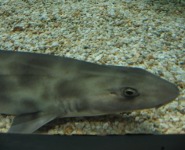
The
Whiskery Shark has been commercially fished by humans since the 1940s, yet relatively little is known about this animal's behavior and social structure. With other less interesting species receiving extensive study, why does this shark remain shrouded in mystery?
The Whiskery Shark (
Furgaleus Macki), averages around 20-25cm or 8-10 inches at birth. Average adult length of males is 110-135cm or 43-53 inches, females 110-132cm or 43-52 inches. The heaviest weight on record is 12.9kgs or 28lbs. The average number of pups per litter is 9-10, but up to 24 is possible.
The diet of the Whiskery Shark consists of octopus, squid,
fish and even lobsters. With this refined taste in food it's no surprise that this poor little ocean creature is considered very tasty by land-dwellers since the diet of an animal tends to influence the flavor of its flesh. Despite the Whiskery Shark's limited range, it is eaten quite heavily by humans under different generic names. Few meats are that ambiguous, except perhaps chicken. Maybe the Whiskery Shark is the true chicken of the sea, since tuna has it's own distinctive flavor and is easy to identify among other varieties of fish.
This type of shark has been overfished since the 1940s, though recent advances in fishing techniques have increased the amount of Whiskery Sharks taken from the ocean immensely. An estimated 75% reduction of virgin population mass puts this animal in real danger of extinction. However, population levels have held steady since the mid 1980s due in large part to the restrictions Australia has put in place regarding the fishing practices surrounding this animal. As long as these rules are enforced, the Whiskery Shark should be safe. The shark is considered harmless to humans.
In physical appearance the Whiskery Shark is elongated and slender, even more so than the average shark. It has anterior nasal flaps which elongate into barbells. The snout of the shark is broad and short and the nose is separated from the mouth. The eyes are dark and oval in shape. Teeth are very sharp and blade-like. The dorsal fins are similar in size and tend to be symmetrical. The dorsal fins are always larger than the anal fin.
Coloring of this animal changes with age. Young specimens have dark blotching all over the body and tend to be a creamy white color. As the age of the animal increases the body darkens to a more brownish shade and it's not uncommon for the blotching to disappear completely. In darker colored adults, the underside remains pale in comparison to the rest of the animal.
The Whiskery Shark has been called by a variety of other names including Flake, Reef Shark, Snaky and Sundowner.
Picture of the whiskery shark by Joe Bennett, licensed under
Creative Commons Attribution 2.0 Generic license.
You can help spreading the word about this animal by liking it on facebook
Permanent Link
Thursday 03 February 2011
Central American squirrel monkey - A Masked Miniature Monkey
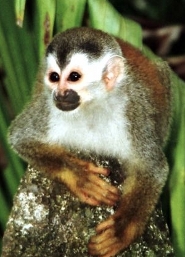
Sadly, the rather appealing appearance and amusing nature of the
Central American Squirrel Monkey (
Saimiri oerstedii) is one of the factors that has led to the decline in wild populations throughout its natural habitat in Panama and Costa Rica. This tiny monkey was prized by exotic pet collectors and therefore captured for sale abroad by unscrupulous traders. The masked primate continues to lose more and more of its natural habitat to deforestation, and it remains a target for hunters. In 2008, the IUCN status was upgraded from "endangered" to "vulnerable," even though there are approximately 5000 specimens of this monkey in the wild, down from 200,000 in the 1970's.
The Central American Squirrel Monkey is a tiny animal; a male might reach a body weight of 829 g (29.2 oz) and a typical female weighs 695 g (24.5 oz). Their length ranges from 266 to 291 millimetres (10.5 to 11.5 in), which does not include the tail. In fact, the monkey's tail is longer than its body, and it measures from 362 to 389 mm (14.3 to 15.3 in).
The species is considered omnivorous; it feeds on fruits and plant materials as well as insects, insect larvae, bats, birds, lizards and other small vertebrates. Farmers often complain that these monkeys eat mango crops, which is the main reason that hunting of this species continues even though its population has already been so substantially reduced. The Central American Squirrel Monkey is particularly adept at hunting bats; its method of preying on bats consists of attacking bat tents and eating bats that do not flee in time.
In turn, the Central American Squirrel Monkey is vulnerable to predators, including snakes, a native species of falcon and other birds, as well as cats. Over 50% of infant monkeys do not survive to adulthood due to bird attacks, despite a remarkable warning system through which males make a high-pitched alarm sound to warn of oncoming birds of prey.
In both Panama and
Costa Rica, the Central American Squirrel Monkey lives only along the Pacific coast, where it lives among young trees, either in secondary forests which have regrown after deforestation, or in partially logged primary forests. Therefore, its habitat is very limited, and this, combined with its susceptibility to attacks by predatory birds and snakes, does not bode well for the survival of these little masked primates.
Picture of the central american squirrel monkey by Linda De Volder, licensed under
Creative Commons Attribution-ShareAlike 3.0 License.
You can help spreading the word about this animal by liking it on facebook
Permanent Link
Wednesday 02 February 2011
The Queen parrotfish - Cocoon Maker
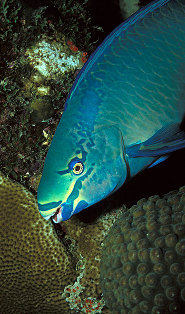
The
Queen parrotfish (
Scarus vetula) is a brightly colored fish which lives mainly off the coral reefs in the Caribbean. The Queen Parrotfish as an adult will be between 15.2 to 25.4 cm or 6 to 10 inches in length with the maximum length recorded being 30.5 cm or 12 inches. This fish is known to secrete a mucus cocoon which it sleeps in. This cocoon helps to cover its scent, making it easier for the Queen Parrotfish to avoid its predators such as eels, sharks and groupers.
While the Queen Parrotfish resides mainly in the Caribbean, it can survive in other areas where the water is warm and there are reefs from which it can gather food. The Queen Parrotfish eats algae that is scrapes from the coral. It is found in regions off the coast of Florida as well as throughout the Western Atlantic Ocean as well as to the coast of South America. Currently it is not considered to be endangered, but heavy fishing is limiting the numbers.
Fish such as the Queen Parrotfish provide a great ecological service by ridding reefs of algae growth which tends to choke out the coral growth causing the reefs to die. Coral reefs are important to the ecosystem. Fish such as the Queen Parrotfish help rid the coral reefs of algae while helping to produce new coral sand through the excretion of newly cleaned sand.
This
fish has a specially designed jaw with teeth which constantly are being regenerated to replace those worn down by the scraping done to remove the algae from the coral. The resulting look is a small, beak like mouth which, in combination with their bright colors, give them the name of parrotfish. While they tend to be brightly colored in adulthood, juvenile queen parrotfish tend to have a white body with black lines.
The classification of the Supermale Queen Parrotfish shows signs of being somewhat larger than the average parrotfish and more brightly colored. This fish reproduces by sending their eggs freely into the surrounding water to be fertilized and hatched. They tend to have over sized scales and very straight fins in addition to their bodies being elongated. The mottled looking colors of the body help them to be somewhat camouflaged while the bright streaks of color can be seen around the mouth area.
Picture of the queen parrotfish by
Laszlo Ilyes, licensed under
Creative Commons Attribution 2.0 Generic license.
You can help spreading the word about this animal by liking it on facebook
Permanent Link
 The Galapagos fur seal (Arctocephalus galapagoensis) is one of the smallest eared seals and is only 1 1/2 meters in length (4.5 feet) and they generally weigh just under 64 Kilograms (141 lbs). These seals have a brownish coat and are found in the Galapagos Island Chain, just west of Ecuador. Though they were once completely endemic to this island chain, colonies of Galapagos fur seals have been established around the world by the Organization for Research and Conservation. As a result, they can now be found as far north as Peru.
The Galapagos fur seal (Arctocephalus galapagoensis) is one of the smallest eared seals and is only 1 1/2 meters in length (4.5 feet) and they generally weigh just under 64 Kilograms (141 lbs). These seals have a brownish coat and are found in the Galapagos Island Chain, just west of Ecuador. Though they were once completely endemic to this island chain, colonies of Galapagos fur seals have been established around the world by the Organization for Research and Conservation. As a result, they can now be found as far north as Peru.
 The
The  The
The  The
The  The
The  Sadly, the rather appealing appearance and amusing nature of the
Sadly, the rather appealing appearance and amusing nature of the  The
The